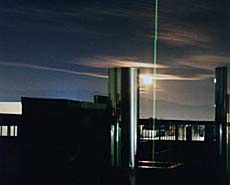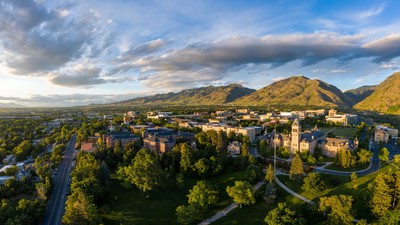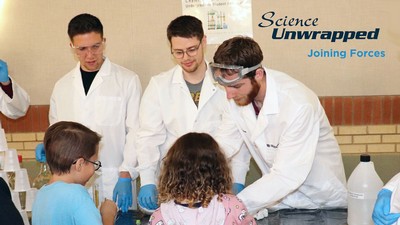Utah State University’s “Green Beam” has been a fixture in Cache Valley’s night sky for the past 17 years. Used to study dynamics of the upper atmosphere, the Rayleigh scatter LiDAR (Light Detection and Ranging) instrument shines a bright green vertical line of light from the top of the university’s Science Engineering Research building that’s visible for miles.
In April 2010, USU’s physics department added the “Gold Beam,” a sodium LiDAR, to its Atmospheric LiDAR Observatory. But unless you’re within about 10 yards of the beam, you won’t be able to see it.
“The human eye isn’t as sensitive to the amber-color of the sodium LiDAR as it is to the green color of the Rayleigh LiDAR,” says Titus Yuan, Gold Beam coordinator. “Plus, the sodium LiDAR emits much weaker beams; less than a watt of power per beam compared to more than 20 watts with the Green Beam.”
In contrast to the Green Beam, which reflects light off of air molecules, the Gold Beam bounces light off of sodium atoms by laser-induced resonance fluorescence. Sodium is among remnants left by meteors that disintegrate as they enter the Earth’s atmosphere some 50 to 70 miles above the planet’s surface.
“It’s a very effective and efficient method of collecting wind and temperature measurements in the mesopause region — that mysterious junction between outer space and the upper atmosphere,” says Yuan, a research assistant professor of physics.
Formerly a part of Colorado State University’s Lidar Group, Yuan and the Gold Beam moved to USU’s Logan campus following Utah State’s successful bid for the instrument.
“The principal investigator of the project was retiring and CSU considered about six sites, including USU, for its new home,” he says. “Utah State is an ideal site because of similar research taking place here and because of its location in relation to Fort Collins, home of Colorado State.”
CSU physicists had been collecting data using the sodium LiDAR for about 20 years. Fort Collins and Logan are situated within one latitudinal degree of each other, meaning that the location from which the Gold Beam now collects data differs little from its former home.
“How we collect the data is important because we’re trying to build a long-term data set covering multiple solar cycles under consistent conditions,” Yuan says. “Having this information could reveal clues about global climate change in the upper atmosphere.”
Housed next to the Green Beam in the SER building, the Gold Beam is split into three rays of light pointing toward the northern, eastern and western skies. Unlike the Green Beam, it functions both day and night.
“My former colleagues at CSU and I developed a Faraday filter that enables us to block out sunlight and continue collecting data throughout a 24-hour period,” Yuan says. “This is important to climatological measurements because temperature and horizontal winds fluctuate so much in the upper atmosphere during a full day.”
Installing the Gold Beam at USU was a challenge, he says, because the instruments and system were never designed to be relocated.
“It took some time to get everything up and working properly.”
In addition to logging measurements, Yuan and his students will observe upper atmospheric turbulence caused by gravity waves.
“Having a sodium LiDAR is like having a microscope that enables us to look at these waves up close,” he says. “
Yuan says he’s excited to be a part of USU and looks forward to working on collaborative atmospheric research projects.
“It’s significant that we have all of these instruments to make concurrent measurements,” he says. “This allows us to generate more robust and valuable data sets.”
Related links:
Writer: Mary-Ann Muffoletto, 435-797-3517,
maryann.muffoletto@usu.edu






